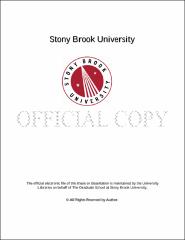| dc.identifier.uri | http://hdl.handle.net/11401/76661 | |
| dc.description.sponsorship | This work is sponsored by the Stony Brook University Graduate School in compliance with the requirements for completion of degree. | en_US |
| dc.format | Monograph | |
| dc.format.medium | Electronic Resource | en_US |
| dc.language.iso | en_US | |
| dc.publisher | The Graduate School, Stony Brook University: Stony Brook, NY. | |
| dc.type | Dissertation | |
| dcterms.abstract | In this dissertation, I present research on four materials with properties that are not well understood, and illustrate the many roles inhomogeneity and disorder may play in material properties. First, we investigated materials synthesis and annealing conditions of the proposed topological superconductor CuxBi2Se3, finding that quenching above a minimum temperature was essential for superconductivity. Due to the inhomogeneity of CuxBi2Se3, we suggest that a metastable secondary phase may be responsible for the superconductivity. Second, we performed neutron scattering measurements on samples in the Fe1+yTe1−xSex family of iron-based superconductors, focusing on the anomalous phonon mode recently discovered near Bragg peaks forbidden by symmetry and at high-symmetry wavevectors where the mode’s neutron scattering intensity is expected to be zero. We characterize this mode and propose that disorder may explain its anomalous visibility. Third, a superconducting crystal of the bilayer cuprate La1.9Ca1.1Cu2O6+δ was synthesized and measured by neutron scattering. Though the magnetic excitations near (0.5,0.5) in reciprocal space resemble those of weakly doped members of the La2−xAexCuO4 (Ae=Ca, Sr, Ba) cuprate superconductor family, the temperature-dependence of the intensity of the magnetic excitations is much different from those of weakly hole-doped cuprates. Superstructural peaks appear to indicate ordering induced by interstitial oxygen, and a comparison with the similarly oxygen-doped cuprate La2CuO4+δ suggests the possibility of phase separation. Fourth, the relaxor ferroelectric Pb(Mg1/3Nb2/3)0.68Ti0.32O3 was measured with neutron scattering while subjected to an electric field. From differences in neutron scattering intensity with and without field, we find a possible coupling between short-range polar correlations and transversely-polarized phonons near certain Brillouin zone centers. | |
| dcterms.abstract | In this dissertation, I present research on four materials with properties that are not well understood, and illustrate the many roles inhomogeneity and disorder may play in material properties. First, we investigated materials synthesis and annealing conditions of the proposed topological superconductor CuxBi2Se3, finding that quenching above a minimum temperature was essential for superconductivity. Due to the inhomogeneity of CuxBi2Se3, we suggest that a metastable secondary phase may be responsible for the superconductivity. Second, we performed neutron scattering measurements on samples in the Fe1+yTe1−xSex family of iron-based superconductors, focusing on the anomalous phonon mode recently discovered near Bragg peaks forbidden by symmetry and at high-symmetry wavevectors where the mode’s neutron scattering intensity is expected to be zero. We characterize this mode and propose that disorder may explain its anomalous visibility. Third, a superconducting crystal of the bilayer cuprate La1.9Ca1.1Cu2O6+δ was synthesized and measured by neutron scattering. Though the magnetic excitations near (0.5,0.5) in reciprocal space resemble those of weakly doped members of the La2−xAexCuO4 (Ae=Ca, Sr, Ba) cuprate superconductor family, the temperature-dependence of the intensity of the magnetic excitations is much different from those of weakly hole-doped cuprates. Superstructural peaks appear to indicate ordering induced by interstitial oxygen, and a comparison with the similarly oxygen-doped cuprate La2CuO4+δ suggests the possibility of phase separation. Fourth, the relaxor ferroelectric Pb(Mg1/3Nb2/3)0.68Ti0.32O3 was measured with neutron scattering while subjected to an electric field. From differences in neutron scattering intensity with and without field, we find a possible coupling between short-range polar correlations and transversely-polarized phonons near certain Brillouin zone centers. | |
| dcterms.available | 2017-09-20T16:50:54Z | |
| dcterms.contributor | Gu, Genda | en_US |
| dcterms.contributor | Tranquada, John M. | en_US |
| dcterms.contributor | Allen, Philip B. | en_US |
| dcterms.contributor | Schneble, Dominik A. | en_US |
| dcterms.contributor | Dawber, Matthew | en_US |
| dcterms.contributor | Yin, Weiguo. | en_US |
| dcterms.creator | Schneeloch, John | |
| dcterms.dateAccepted | 2017-09-20T16:50:54Z | |
| dcterms.dateSubmitted | 2017-09-20T16:50:54Z | |
| dcterms.description | Department of Physics | en_US |
| dcterms.extent | 168 pg. | en_US |
| dcterms.format | Application/PDF | en_US |
| dcterms.format | Monograph | |
| dcterms.identifier | http://hdl.handle.net/11401/76661 | |
| dcterms.issued | 2016-12-01 | |
| dcterms.language | en_US | |
| dcterms.provenance | Made available in DSpace on 2017-09-20T16:50:54Z (GMT). No. of bitstreams: 1
Schneeloch_grad.sunysb_0771E_13067.pdf: 14990488 bytes, checksum: d3564ed6d1a4023ab5f17798991703cc (MD5)
Previous issue date: 1 | en |
| dcterms.publisher | The Graduate School, Stony Brook University: Stony Brook, NY. | |
| dcterms.subject | Physics -- Condensed matter physics -- Materials Science | |
| dcterms.subject | crystal growth, ferroelectrics, neutron scattering, superconductors | |
| dcterms.title | Investigations in the crystal growth and neutron scattering of superconductors and a relaxor ferroelectric | |
| dcterms.type | Dissertation | |

